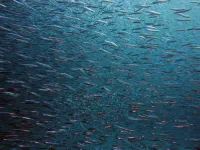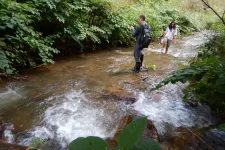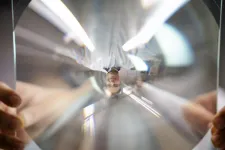(Press-News.org) Darwin’s theory of evolution highlighted the importance of adaption and diversity in the natural world. Inside a biological cell, can proteins also perform new functions in new contexts? The answer seems to be yes for the brain’s primary protein-degradation machine, especially when it is placed at synapses, revealing a hitherto unknown mechanism that allows synapses to change in response to different circumstances.
The role of the regulatory (19S) proteasome particle has always been exclusively linked to its functioning in the proteasome complex, where it collaborates with the catalytic (20S) particle to recognize and remove unwanted or damaged proteins- a mechanism that is crucial for normal brain development and function.
Using a super-resolution imaging technique, called DNA PAINT, the research team noticed an abundance of free 19S particles in synapses, floating around without their 20S partners:
“What we realized was that 19S is not only a partner of 20S. It also works alone as an independent regulator for many key synaptic proteins. This revealed a whole new dimension to our understanding of protein function at synapses,” explains Chao Sun, Associate Professor, and lead author of the article.
The researchers found that the abundant free 19S particles seem to interact with a number of synaptic proteins, including those involved in neurotransmitter release and detection, thus regulating information transfer and storage at synapses.
“Usually, if the cell makes excess copies of one protein component, it needs to get rid of these excess copies. Because cells do not like to have extra proteins lying around when they can’t find partners to enable protein function. We call them ‘orphan proteins’. But in this case, it seems like the synapses are making use of these free 19S particles and adapting them to fulfill alternative functions in the synapses,” Chao Sun explains.
With this new discovery, scientist now has a new target for both understanding and treating neurological diseases with dysfunctional synapses, such as Parkinson’s disease and dementia.
Chao Sun is currently a Group Leader at DANDRITE, and he conducted the research when he worked with the Brain Prize winner Erin Schuman at the Max Planck Institute for Brain Research.
The findings will be published in the journal Science on 26 May and is available online on 25 May at 2 PM.
Link to online article: http://www.science.org/doi/10.1126/science.adf2018
DANDRITE – The Danish Research Institute for Translational Neuroscience is the Danish node of the Nordic EMBL Partnership and funded by the Lundbeck Foundation. Researchers at DANDRITE perform basic and translational research in the brain and the nervous system and aim at unraveling the molecular mechanisms that explain physiological manifestations of cellular communication networks in the brain circuitries and the nervous system and how these are affected in neurological and psychiatric disorders.
about DANDRITE: www.dandrite.au.dk
For more information, contact:
Group Leader and Associate professor at DANDRITE, Chao Sun, chaosun@dandrite.au.dk END
The brain’s protein-destruction machine learns new tricks at synapses, revealing a potential target for treating neurological disorders
2023-05-25
ELSE PRESS RELEASES FROM THIS DATE:
Polar fish are less likely to die early, so they prioritize growth over reproduction
2023-05-25
Polar fish experience lower mortality than tropical fish, allowing them to delay reproduction until later in life when they are larger and can produce more eggs, according to a study by Mariana Álvarez-Noriega at Monash University in Australia and colleagues, publishing May 25th in the open access journal PLOS Biology. This may have implications for the effects of climate change on the sustainability of fish populations.
Organisms face a trade-off around when is the best time to reproduce. Fish continue to grow throughout life and larger fish tend to produce disproportionately more eggs than smaller fish, so it ...
Arctic ground squirrels changing hibernation patterns
2023-05-25
Arctic ground squirrels are unique among mammals. Their ability to keep from freezing even when body temperatures dip below that mark on the thermometer enables them to survive extreme winter climates. New research published in Science analyzes more than 25 years of climate and biological data. The findings include shorter hibernation periods and differences between male and female hibernation periods. Spoiler alert - the girls “rise and shine” a little earlier in response to warming, which could have both positive and negative ripple effects throughout the food web in these ecosystems.
Senior ...
As Arctic warms, female arctic ground squirrels end hibernation before males – a mismatch with consequences
2023-05-25
As Alaskan permafrost warms, hibernating arctic ground squirrels generate less heat, causing females to emerge from hibernation up to 10 days before their male counterparts – a mismatch that could have large, cascading ecological impacts. The findings of the related study reveal both direct and indirect impacts of a warming world. Winter temperatures play a fundamental role in fitness and population dynamics for many species that live in higher latitudes. However, in the Arctic, where warming is occurring more rapidly than most other places on ...
Stressed soil microbial communities bolster tree resilience to changing climates
2023-05-25
Soil microbiota transplanted from more stressful environmental conditions – drought or excessive heat or cold, for example – can enhance tree tolerance to changing climates, researchers report. The findings suggest that management of soil microbiota, especially during forest restorations, could be a valuable strategy for increasing forest resilience to climate change. Climate change is forcing many species outside of their evolved range of environmental tolerances, forcing them to acclimate, adapt, or migrate to avoid extinction. For long-lived ...
Combining data types refines grasp of French Canadian ancestry in Quebec, revealing how local topographies influenced relatedness, and more
2023-05-25
Combining a comprehensive dataset – including marriage documents – compiled from more than 4 million Catholic parish records with genotype data for more than 22,000 French and French Canadian individuals, researchers have conducted a novel analysis of French Canadian ancestry in Quebec, Canada, since the 17th Century. While most other population genetic models provide only coarse representations of a region’s real-world ancestry, this new approach reveals detailed insights into historic European colonization, migration, and settlement patterns, reflecting intricate French Canadian population structures within geographic constraints. ...
International pandemic governance need not prioritize compliance and sanctions
2023-05-25
In a Policy Forum, Mark Eccleston-Turner and colleagues argue that upcoming negotiations surrounding the World Health Organization (WHO) international pandemic treaty need not be overly focused on formal compliance mechanisms and sanctions. Instead, Eccleston-Turner et al. suggest that any efforts to ensure compliance should be part of broader efforts to ensure effective and equitable implementation across all member states. Member states of the World Health Organization (WHO) are preparing for ambitious ...
River erosion can shape fish evolution, study suggests
2023-05-25
If we could rewind the tape of species evolution around the world and play it forward over hundreds of millions of years to the present day, we would see biodiversity clustering around regions of tectonic turmoil. Tectonically active regions such as the Himalayan and Andean mountains are especially rich in flora and fauna due to their shifting landscapes, which act to divide and diversify species over time.
But biodiversity can also flourish in some geologically quieter regions, where tectonics hasn’t shaken up the land for millennia. The Appalachian Mountains are a prime example: The range ...
River erosion drives fish biodiversity in the Appalachians
2023-05-25
New Haven, Conn. — The gradual erosion of layers of rock by rivers flowing through the Appalachian Mountains generates biodiversity of freshwater fish species, suggests a new Yale-led study that offers insight into the causes of species richness in the ancient mountain range.
Researchers have previously associated high biodiversity in mountain ranges, including the Andes and Himalaya, with tectonic uplift — the shifting of plates in the Earth’s crust that forms mountains, plateaus, and other geologic structures — triggering environmental changes that create conditions ripe for species diversification. ...
Researchers at the Faculty of Physics of the University of Warsaw have created a new, highly efficient converter of quantum information carriers
2023-05-25
Researchers at the University of Warsaw's Faculty of Physics have developed a new, highly efficient technique that makes quantum information transmission dozens of times faster. The results of the research, published in the prestigious journal Nature Photonics, may in the near future contribute to the development of superfast quantum Internet connections.
Light is a key carrier of information. It enables high-speed data transmission around the world via fiber-optic telecommunication networks. This information-carrying capability can be extended to transmitting quantum information by encoding ...
Making the structure of 'fire ice' with nanoparticles
2023-05-25
Images // Video
Cage structures made with nanoparticles could be a route toward making organized nanostructures with mixed materials, and researchers at the University of Michigan have shown how to achieve this through computer simulations.
The finding could open new avenues for photonic materials that manipulate light in ways that natural crystals can't. It also showcased an unusual effect that the team is calling entropy compartmentalization.
"We are developing new ways to structure ...



